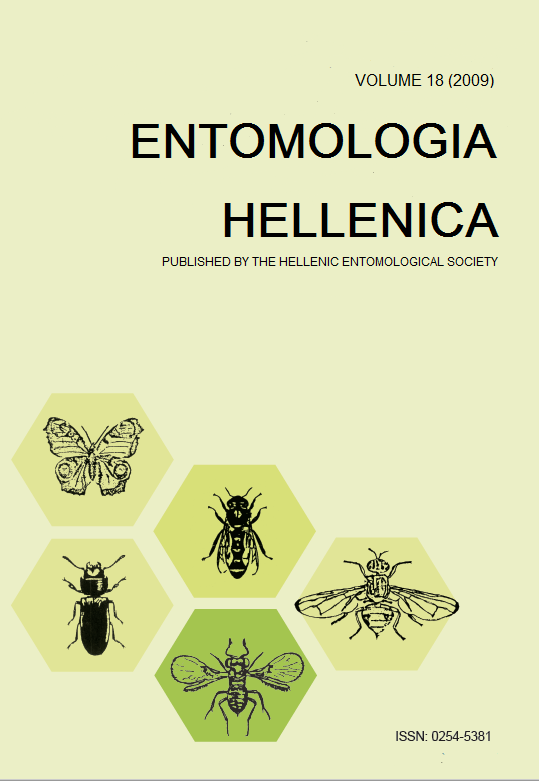Αλληλεπιδράσεις μεταξύ των παρασιτοειδών Leptomastix epona και Pseudaphycus flavidulus στον παρασιτισμό του ψευδόκοκκου Pseudococcus viburni
Περίληψη
Τα είδη Leptomastix epona (Walker) και Pseudaphycus flavidulus (Brèthes) (Hymenoptera: Encyrtidae) είναι ενδοπαρασιτοειδή του ψευδόκοκκου Pseudococus viburni (Signoret) (Hemiptera: Pseudococcidae). Το L. epona είναι μονήρες παρασιτοειδές που κατάγεται από την Ευρώπη και το P. flavidulus είναι πολλαπλό παρασιτοειδές από τη Νότια Αμερική. Μελετήθηκε η ικανότητα των παρασιτοειδών να αναγνωρίζουν μη παρασιτισμένα ενήλικα θηλυκά (ξενιστές) του ψευδόκοκκου από άλλα που έχουν παρασιτιστεί προηγουμένως από άτομα του ίδιου ή του άλλου παρασιτοειδούς (host discrimination), σε διάφορα χρονικά διαστήματα μεταξύ της αρχικής και της επόμενης ωοτοκίας. Ακμαία θηλυκά του L. epona αναγνωρίζουν μη παρασιτισμένους ξενιστές του ψευδόκοκκου από άλλους που έχουν παρασιτιστεί 0-96 ώρες νωρίτερα από διαφορετικό άτομο του ίδιου παρασιτοειδούς επιλέγοντας συχνότερα τους πρώτους έναντι των δεύτερων για ωοτοκία. Ακμαία θηλυκά του P. flavidulus αναγνωρίζουν τους μη παρασιτισμένους ξενιστές από εκείνους που έχουν παρασιτιστεί 0-72 ώρες πριν από άλλο θηλυκό του ίδιου είδους. Επιπλέον παρατηρείται επιπαρασιτισμός από διαφορετικά άτομα του ίδιου είδους (conspecific superparasitism) και στα δύο παρασιτοειδή. Η δευτερογενής αναλογία φύλου (ποσοστό αρσενικών απογόνων) του L. epona και ο αριθμός των απογόνων/ξενιστή του P. flavidulus δεν επηρεάζονται από τον επιπαρασιτισμό. Αντίθετα η δευτερογενής αναλογία φύλου του P. flavidulus είναι μεγαλύτερη στους ξενιστές όπου έχει γίνει επιπαρασιτισμός σε σχέση με αυτούς που έχουν παρασιτιστεί μία μόνο φορά. Το μονήρες παρασιτοειδές L. epona δεν αναγνωρίζει μη παρασιτισμένους ξενιστές από άλλους που έχουν παρασιτιστεί από το P. flavidulus 0-3 ή 24 ώρες νωρίτερα. Αντίθετα το πολλαπλό παρασιτοειδές P. flavidulus αναγνωρίζει μη παρασιτισμένους ξενιστές από άλλους παρασιτισμένους από το L. epona 0-3 ώρες νωρίτερα αλλά ωοτοκεί χωρίς διάκριση σε ξενιστές που έχουν παρασιτιστεί από το L. epona 24 ώρες πριν. Όταν λαμβάνει χώρα πολυπαρασιτισμός (multiparasitism) 0-3 ώρες μετά την πρώτη ωοτοκία, το L. epona υπερέχει στον εσωτερικό ανταγωνισμό ανεξάρτητα από το ποιο παρασιτοειδές έχει ωοτοκήσει πρώτο. Ωστόσο, όταν το διάστημα μεταξύ δύο ωοτοκιών είναι 24 ώρες, η πιθανότητα του απογόνου του P. flavidulus να κερδίσει τον ανταγωνισμό με το L. epona αυξάνεται οποιοδήποτε παρασιτοειδές και να ωοτοκήσει πρώτο. Συζητείται η πιθανή επίδραση του πολυπαρασιτισμού στην συνύπαρξη των δύο παρασιτοειδών στην προοπτική της εισαγωγής ή μαζικής απελευθέρωσης των δύο ειδών για τη βιολογική αντιμετώπιση του ψευδόκοκκου.
Λεπτομέρειες άρθρου
- Πώς να δημιουργήσετε Αναφορές
-
Karamaouna, F., & Copland, M. (2009). Αλληλεπιδράσεις μεταξύ των παρασιτοειδών Leptomastix epona και Pseudaphycus flavidulus στον παρασιτισμό του ψευδόκοκκου Pseudococcus viburni. ENTOMOLOGIA HELLENICA, 18, 17–34. https://doi.org/10.12681/eh.11605
- Τεύχος
- Τόμ. 18 (2009)
- Ενότητα
- Articles

Αυτή η εργασία είναι αδειοδοτημένη υπό το CC Αναφορά Δημιουργού – Μη Εμπορική Χρήση – Παρόμοια Διανομή 4.0.
Authors who publish with this journal agree to the following terms:
Authors retain copyright and grant the journal right of first publication with the work simultaneously licensed under a Creative Commons 4.0 license.
Authors are able to enter into separate, additional contractual arrangements for the non-exclusive distribution of the journal's published version of the work (e.g. post it to an institutional repository or publish it in a book), with an acknowledgement of its initial publication in this journal. Authors are permitted and encouraged to post their work online (preferably in institutional repositories or on their website) prior to and during the submission process, as it can lead to productive exchanges, as well as earlier and greater citation of published work.



